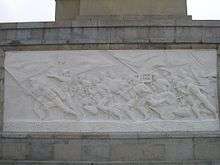1954 Yangtze River floods
From June to September 1954, the Yangtze River Floods were a series of catastrophic floodings that occurred mostly in Hubei Province. Due to unusually high volume of precipitation as well as an extraordinarily long rainy season in the middle stretch of the Yangtze River late in the spring of 1954, the river started to rise above its usual level in around late June. Despite efforts to open three important flood gates to alleviate the rising water by diverting it, the flood level continued to rise until it hit the historic high of 44.67 m in Jingzhou, Hubei and 29.73 m in Wuhan. The number of dead from this flood was estimated at around 33,000, including those who died of plague in the aftermath of the disaster.
Casualties

Partly as a result of this flood, the pressure to build new dams, the Gezhouba Dam and the Three Gorges Dam, in the upper reach of Yangtze river, gained considerable momentum.
Commemoration
In 1969, a large stone monument was erected in the riverside park in Hankou (City of Wuhan, Hubei) honoring the heroic deeds in fighting the 1954 flood. Among the carvings on the monument is a calligraphic inscription by Mao Zedong, dedicated to the people of Wuhan:[2]
We must still be prepared to do battle against and overcome similarly severe floods that may occur in the future.
Below, is his poem "Swimming"[3] (1956), envisioning future bridge and dam construction on the Yangtze:[4]
| “ | I have just drunk the waters of Changsha And come to eat the fish of Wuchang. Now I am swimming across the great Yangtze, Looking afar to the open sky of Chu. Let the wind blow and waves beat, Better far than idly strolling in a courtyard. Today I am at ease. "It was by a stream that the Master said - "Thus so things flow away!""
|
” |
On the sides of the monument's pedestal are reliefs depicting heroic people of Wuhan fighting the flood, raising banners and placards with quotations from Mao Zedong.
Comparison
Compared to the 1998 Yangtze River Floods, this flooding was more severe in terms of total flow of water, but less in terms of the highest level that the flood water reached. This is probably a result of the intense logging on the banks of the upper reach of Yangtze River during the later part of the 20th century.
See also
References
- ↑ “一不怕苦,二不怕死”
- ↑ "Inscription on the triumph of the people of Wuhan over the flood", in: The Writings of Mao Zedong, 1949-1976. Book by Michael Y. M. Kau, John K. Leung, Tse-tung Mao; M. E. Sharpe, 1986. 778 pgs. Page 511.
- ↑ "Swimming" by Mao Zedong
- ↑ Imperial Tours - Three Gorges Dam
